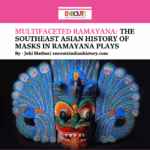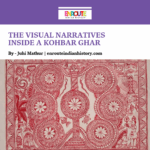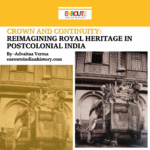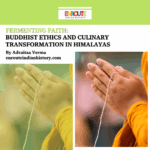
By Riya Pradhan
Beauty has always been a mirror of cultural values, and the male form is no exception. From the straight terracotta figures of the Harappan city-states to the ethereal gods of Bhakti poetry, ideals of what makes a man good-looking in India associate physical appearance with moral, spiritual, and social qualities. In every period, poets and artists portrayed not only muscles and faces but also the ethical and spiritual attributes that were desired in a man.
This essay traces the evolution of male beauty. It begins with the uncomplicated forms of Harappan figurines- breaded priest, proceeds to the martial heroes of the Epics, the urbane sensitivities of the Kamasutra, the passion-fueled ardor for Krishna, and concludes with the hybrid mythological and realistic paintings of Raja Ravi Varma. This is the way in which male beauty was an expression of grander notions of art, philosophy, and politics. It also implies an ongoing dialogue between appearance and reality: the body as a palimpsest upon which shifting notions regarding duty, desire, and devotion are inscribed.
Harappan Aesthetics- Early representations
The Harappan civilization offers some of the earliest depictions of the human form in the Indian subcontinent. Although smaller in number than female figurines, male figurines also exhibit a slender body and protruding features implying a social preference for linear forms and the concomitant ritual or social connotations.
Archaeological evidence from the Harappan civilization presents early ideals of masculine beauty through sculptures, seals, and figurines. Terracotta figurines and seals of the time depict male figures with typical characteristics. Specifically, a bearded man terracotta effigy with a coiled hair bun, possibly a priestly or divine emblem, has a stiffly upright stance, suggesting a traditional icon of priesthood and divinity. Such artifacts suggest an early identification of some masculine traits, such as a calm disposition and possibly spiritual significance.
Vedic period- Valour and Spirituality
In the Vedic period, male beauty was closest to concepts of valour, spiritual knowledge, and adherence to dharma (righteousness). In the Rigveda, and in other Vedic texts, male gods and heroes are typically described with radiant bodies, physical strength, and moral endurance. Physical attributes like strong arms and lotus-like eyes are common themes in the praise poems of the Rigveda. The main focus was not on physical attractiveness rather on virtues such as bravery, intelligence, and religious adherence.
The Epics- Ramayana and Mahabharata
The most celebrated Indian epics, Mahabharata and Ramayana bring together ideas on masculine aesthetics coupled with strength and moral ethics. Arjuna and Rama are portrayed as ideals of physical perfection, moral virtue, and martial excellence. In the Vanaparvan of the Mahabharata, male beauty is linked with attributes of height, broad shoulders, and an authoritative presence, which symbolize physical and moral virtue.
Kamadeva: The embodiment of desire
Kamadeva, the Hindu deity of love and desire, personifies the beauty standards of masculine beauty in ancient Indian mythology. The Puranas such as- Shiva Purana, Matsya Purana etc describe Kamadeva as having a golden complexion, a powerful chest, and features resembling lotus petals. He is often depicted with a sugarcane bow and arrows topped with flowers, which signify the power of desire and attraction, respectively. Kamadeva's descriptions reflect a cultural sensitivity to sensuality and an idealization of passionate love.
Kamasutra- cultural conventions
Vatsyayana's Kamasutra describes the ideal male physique, which has smooth, glossy skin, even limbs, well-defined thighs, and a tight waist. These physical features are matched by cultivated traits such as eloquent speech, musicality, poetic diction, and artistry, which are regarded as vital components of male charm. The book discusses the virtues attributed to men, highlighting the importance of meticulous grooming, etiquette, and cultural sophistication. A pleasing appearance, proficiency in many arts, and cultivated manners were regarded as the key virtues of a charming man, in line with the social emphasis on overall personal development.
Kalidasa's Portraits of Regal Beauty
Kalidasa's literary universe elevates male beauty to a different pedestal. Kalidasa's heroes' beauty is linked to values such as humility, courage, and devotion. Thus, aesthetics becomes an external representation of inner dharmic force, a harmonious fusion of form and spirit. His lyrical imagery frequently compares human beauty to natural beauty, emphasizing the importance of balance between form and substance. For example in Abhinyanshakuntalam King Dushyanta's entrance is marked by regal bearing and "sweet address," his prince-like countenance forging immediate charm in Shakuntala—a dramatization of the manner virtue and face mix to create the ideal masculine figure.
Bhakti movement- the Devotional Beauty
The Bhakti movement, which lasted from the 12th to the 17th century, transformed the nature of religious devotion in medieval India, emphasizing on personal and emotional commitment to the divine, particularly in the worship of Lord Krishna. Beauty linked with divine masculinity in this era was an enormous spur for emotional and spiritual identification. Description of Krishna's beauty in Bhakti saint-poets' poetry created intense devotional longing and romantic ardor.
The celebrated Rajput princess and saint-poetess, Mira Bai, writes one of the best examples of Bhakti's vision of love and devotion to God, often addressing Krishna as her "beloved dark prince." Her poetry centers on Krishna's dark complexion, slender physique, and irresistible smile, depicting him as a charming and captivating figure who captivates both heart and soul. In her poetry, Krishna's physical beauty is inextricably linked with his divine nature.
Surdas, a poet-saint, is an important figure whose hymns praise the physical beauty of Krishna, with an emphasis on his youth and handsomeness. Surdas's poetry praises Krishna's attributes, with curly hair, lotus- shaped eyes, and an irresistible smile. This beauty is more than just visual, being closely related to his mischievous and divine nature. In Bhakti poetry, Krishna's beauty surpasses physical characteristics to represent spiritual mercy.
Raja Ravi Verma: A colonial rebirth of ancient ideals
Raja Ravi Varma transformed the perception of male beauty in the nineteenth century through his paintings by blending Indian mythology and European realistic style. His projections of mighty gods and heroes, i.e., Krishna and Arjuna, show them as tall and robust, with soft but stern faces, traditional appearances, and a dignified demeanor. Ravi Varma's paintings updated traditional ideas to fit modern feelings by painting portraits of male beauty that both exuded power and inner tranquility.
For almost four thousand years, Indian ideals of male beauty have not only been for show; they expressed what it meant to be good, strong, and pleasing. Whether of clay, in ancient poetry, in beautiful Sanskrit verse, or on canvas, the male beauty always carried deep meanings about ethics, the spirit, and society. The lean and austere look of a Harappan priest, the heroic figure of Arjuna, the urbane charm of Krishna, and the realistic portraiture of Ravi Varma's heroes each has a unique relationship between beauty and values. By looking at these changing examples, we see that "beauty" does more than just pleasing the eyes; it is also the expression of a civilization's highest ideals—its idea of duty, loyalty, and desire shaped, in each age, around the living form of man.
References
Dehejia, V. (2009). The Body Adorned: Sacred and Profane in Indian Art
Sahgal, S. (2018). Constructing 'Vedic' Masculinities
Clark, S.R. (2009). Material Matters: Representation and Materiality of the Harappan Body
Singh, N. (2001). The Context of Bhakti Poetry in Medieval India
Kinsley, D. (1972). Without Krishna There Is No Song: Gita Govinda and Bhakti Aesthetics. University of Chicago Press
Benton, C. (2006). Representing the Indus Body: Sex, Gender, Sexuality, and the Anthropomorphic Terracotta Figurines from Harappa.
Rao, T. A. G. (1914). Elements of Hindu Iconography. Law Printing House
Mahapatra, A. (2018). Gender Equality and Ancient Indian Culture: A Study. International Journal of Humanities and Social Science Invention, 7(8), 22–26
Ghosh, M. (1951). The Nātyaśāstra: A Treatise on Hindu Dramaturgy and Histrionics. Asiatic Society



















